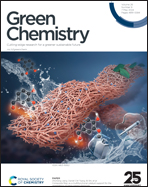Carbonic anhydrase assisted acidogenic fermentation of forest residues for low carbon hydrogen and volatile fatty acid production: enhanced in situ CO2 reduction and microbiological analysis
Abstract
Carbonic anhydrase (CA) is considered an efficient enzyme for fermentation systems exhibiting a wide range of applications, enhancing both the efficacy and output of the fermentation process. The present study aimed to evaluate the production of acidogenic biohydrogen (bioH2) and volatile fatty acids (VFA) using forest residues as a renewable feedstock. Specifically, the study examined the integration of CA derived from Desulfovibrio vulgaris into the acidogenic fermentation (AF) process. The experimental procedure involved a cascade design conducted in two distinct phases. In phase I, the concentration of CA in the AF was systematically optimized, with glucose serving as the substrate. In phase II, three influential parameters (pH, pressurization with in situ generated gas and organic load) were evaluated on AF in association with optimized CA concentration from phase I. In phase II, glucose was replaced with renewable sugars obtained from forest residues after steam explosion pretreatment followed by enzymatic saccharification. The incorporation of CA in AF was found to be beneficial in steering acidogenic metabolites. Alkaline conditions (pH 8) promoted bioH2, yielding 210.9 mLH2 gCOD−1, while introducing CA further increased output to 266.6 mLH2 gCOD−1. This enzymatic intervention improved the production of bioH2 conversion efficiency (HCE) from 45.3% to 57.2%. Pressurizing the system accelerated VFA production with complete utilization of in situ produced H2 + CO2 compared to non-pressurized systems. Particularly, caproic acid production was improved under pressurized conditions which was accomplished by the targeted enrichment of chain-elongating bacteria in the mixed culture. The microbial diversity analysis showed the dominance of Firmicutes suggesting a significant degree of adaptation to the experimental contexts, leading to an enhanced production of acidogenic metabolites.



 Please wait while we load your content...
Please wait while we load your content...